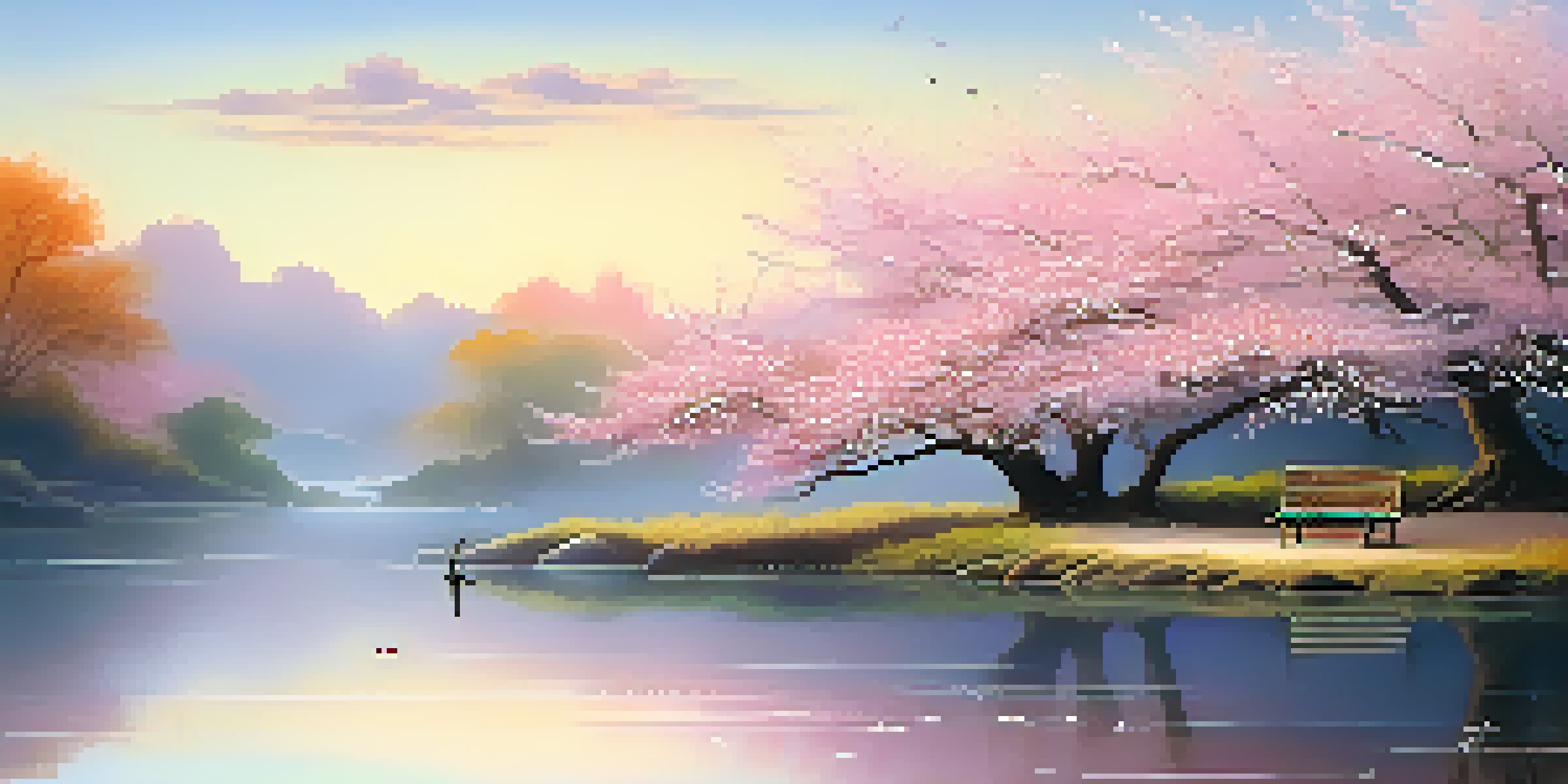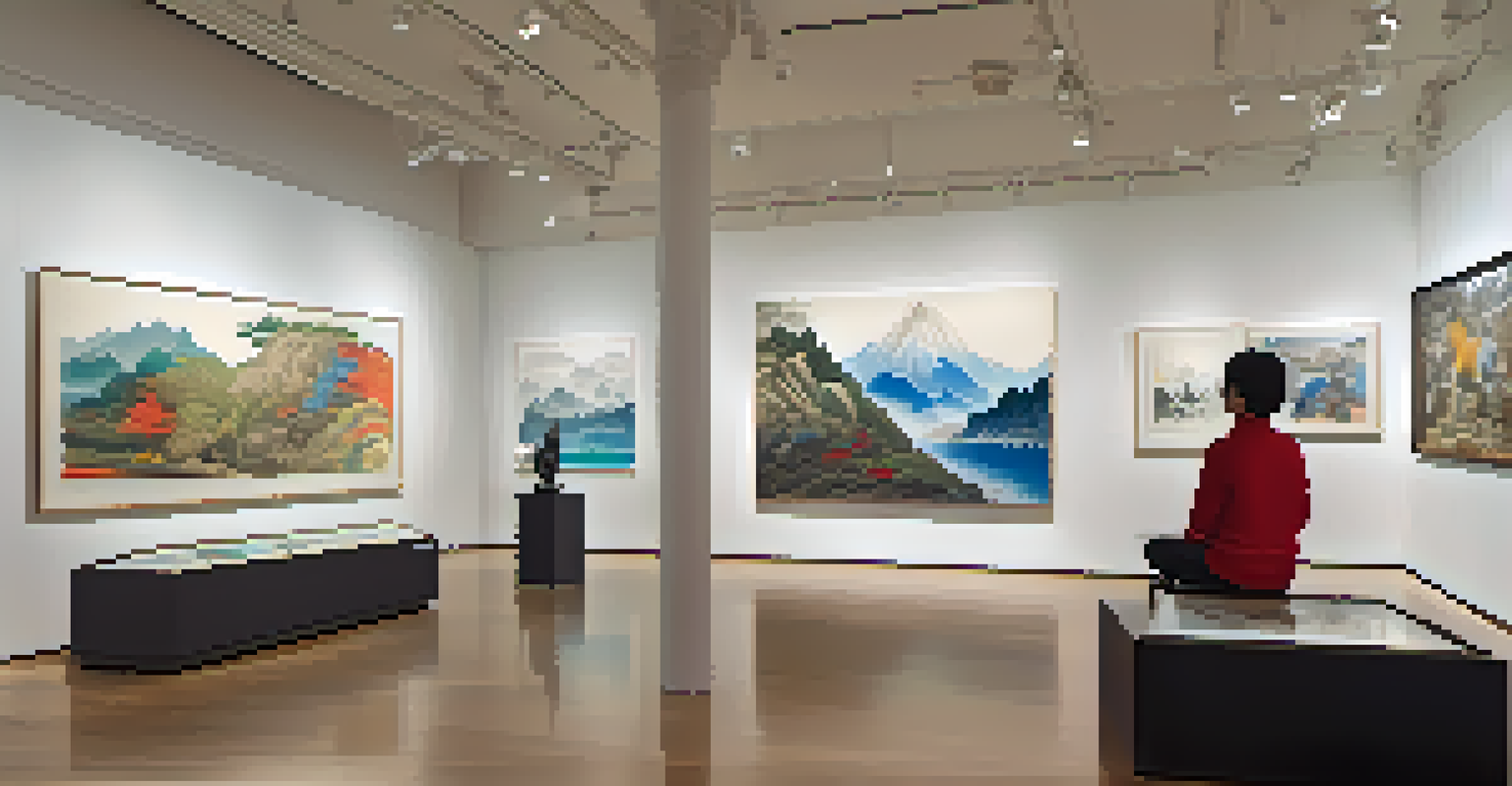The Aesthetic Value of Eastern Art in Western Galleries

The Cultural Fusion of Eastern and Western Art
The blending of Eastern and Western art forms creates a rich tapestry of cultural expression. In galleries across the West, Eastern art pieces often serve as a bridge, allowing viewers to appreciate diverse artistic traditions. This fusion not only enhances the aesthetic experience but also fosters a deeper understanding of different cultures.
Art is the most beautiful of all lies.
For instance, a traditional Japanese ink painting might hang alongside a contemporary Western sculpture, highlighting the contrast and complementarity of styles. As visitors move through these galleries, they encounter a dialogue between these distinct artistic philosophies, sparking curiosity and appreciation. This cultural exchange enriches the viewer's experience and broadens their artistic horizons.
Moreover, such exhibitions challenge preconceived notions about art and beauty. They encourage audiences to embrace a more inclusive perspective, recognizing the value in artistic expressions from different parts of the world. This evolving narrative in galleries reflects a growing appreciation for the aesthetic contributions of Eastern art.
The Unique Aesthetic Qualities of Eastern Art
Eastern art is renowned for its unique aesthetic qualities, often emphasizing harmony, balance, and nature. Traditional Chinese landscape paintings, for example, use fluid brushstrokes and subtle color palettes to evoke a sense of tranquility. This dedication to capturing the essence of nature resonates deeply with many viewers in Western galleries.

In contrast to some Western art forms that prioritize realism, Eastern art often embraces abstraction and symbolism. This approach invites the audience to interpret meaning on a personal level, allowing for a more intimate connection with the artwork. The layers of meaning found in these pieces often provoke reflection and contemplation among viewers.
Cultural Exchange Enriches Art
The blending of Eastern and Western art creates a rich dialogue that enhances understanding and appreciation of diverse artistic traditions.
Furthermore, the use of space in Eastern art is distinct and intentional. Negative space, or the area around and between subjects, plays a critical role in conveying emotions and ideas. This technique encourages viewers to engage not just with the art itself, but also with their own thoughts and feelings, enhancing the overall aesthetic experience.
Eastern Art's Influence on Western Artists
The allure of Eastern art has significantly influenced many Western artists throughout history. Movements such as Impressionism and Modernism show traces of Eastern aesthetics in their embrace of light, color, and form. Artists like Claude Monet were inspired by Japanese prints, incorporating elements of those styles into their own work.
The more we know about others, the more we understand ourselves.
This cross-pollination of ideas has led to the emergence of hybrid art forms that celebrate both Eastern and Western traditions. By melding techniques and philosophies, contemporary artists create works that resonate with a diverse audience, showcasing the beauty of collaboration. This blending of styles not only enriches the art world but also emphasizes the interconnectedness of global cultures.
Moreover, exhibitions featuring Eastern art often inspire Western artists to explore new themes and techniques. The exposure to these distinct artistic practices encourages innovation and experimentation, leading to the creation of unique artworks that reflect a broader worldview. This ongoing dialogue between Eastern and Western artists continues to shape the landscape of contemporary art.
The Role of Western Galleries in Promoting Eastern Art
Western galleries play a crucial role in promoting Eastern art and making it accessible to a wider audience. By curating exhibitions that showcase these works, galleries provide a platform for appreciation and education. This visibility not only elevates Eastern artists but also introduces viewers to new perspectives and cultural narratives.
Furthermore, galleries often host events, talks, and workshops that delve deeper into the significance of Eastern art. These initiatives help demystify the art forms and foster a greater understanding of their cultural contexts. Such educational opportunities encourage dialogue and engagement, allowing visitors to connect with the artwork on a more profound level.
Unique Qualities of Eastern Art
Eastern art emphasizes harmony, balance, and abstraction, inviting viewers to engage deeply with the artwork and reflect on personal interpretations.
In addition, collaborations between Eastern and Western artists within galleries can lead to innovative projects that celebrate diversity. By showcasing these partnerships, galleries highlight the beauty of cultural exchange and inspire future generations of artists. This commitment to promoting Eastern art ultimately enriches the artistic landscape in the West.
Challenges in Representing Eastern Art
While the presence of Eastern art in Western galleries is growing, there are challenges in its representation. One of the main issues is the risk of cultural appropriation, where elements of Eastern art are used without proper understanding or respect for their origins. This can lead to misinterpretations that dilute the true meaning and significance of the artwork.
Additionally, the commercialization of Eastern art poses a challenge. As galleries seek to attract visitors, there's a tendency to simplify or sensationalize the art to fit Western tastes. This undermines the complexity and depth of Eastern artistic traditions, reducing them to mere decorative objects rather than cultural expressions.
Moreover, the lack of representation of Eastern artists in Western galleries can perpetuate stereotypes and limit the audience's understanding. It's essential for galleries to strive for authentic representation that honors the diversity of Eastern art and its creators. This commitment to integrity ensures a more accurate portrayal of artistic traditions and fosters genuine appreciation.
The Future of Eastern Art in Western Galleries
The future of Eastern art in Western galleries looks promising as interest continues to grow. With a greater emphasis on inclusivity and diversity, galleries are increasingly recognizing the importance of showcasing Eastern artistic traditions. This trend not only enriches the cultural landscape but also fosters a more comprehensive understanding of global art.
Moreover, technological advancements and digital platforms have made Eastern art more accessible than ever. Virtual exhibitions, online galleries, and social media allow artists to reach wider audiences and connect with enthusiasts worldwide. This shift opens up new avenues for appreciation and engagement, breaking down geographical barriers.
Galleries Promote Eastern Art
Western galleries play a vital role in making Eastern art accessible, fostering appreciation through curated exhibitions and educational initiatives.
As art continues to evolve, the integration of Eastern art into Western galleries will likely inspire new artistic movements. The blending of styles and ideas will create exciting opportunities for collaboration and innovation. Ultimately, this dynamic exchange will shape the future of art, reflecting the rich tapestry of human creativity and cultural heritage.
Celebrating the Aesthetic Value of Eastern Art
Celebrating the aesthetic value of Eastern art is essential for fostering a more inclusive art world. By recognizing the beauty and significance of these artistic traditions, we can cultivate a deeper appreciation for the diverse expressions of human creativity. This celebration not only enriches our cultural experiences but also encourages dialogue and understanding among different communities.
Additionally, engaging with Eastern art invites us to reflect on our own perspectives and biases. It challenges us to move beyond surface-level interpretations and embrace the richness of cultural narratives. This introspection is vital for building a more empathetic and interconnected global community.

As we continue to explore the aesthetic value of Eastern art in Western galleries, let us celebrate the beauty it brings to our lives. By honoring these artistic traditions and their creators, we contribute to a more vibrant and diverse art world that reflects the vast spectrum of human experience.